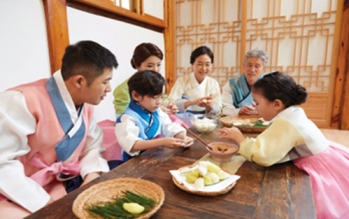Similarity between Korean harvest fest Chuseok (추석) and India’s Bihu, Vaisakhi, Holi, Pongal, Kummi Tarpa and Karma
Chuseok— the Korean thanksgiving, which is being celebrated today on 10th Sep in 2022, is one of the representative traditional Korean festivals celebrated in autumn on the full moon of the 15th day of the 8th month of the lunar calendar.

Written By Hwang Il-yong, Director of Korean Cultural Centre India (KCCI,) New Delhi. With the coming of fall, festive spirits slowly start enveloping the air all around the world. Chuseok — the Korean thanksgiving, is one of the representative traditional Korean festivals celebrated in autumn on the full moon of the 15th day of the 8th month of the lunar calendar. Chuseok, also known as ‘Hangawi’ (한가위), is a mid-autumn harvest festival where families gather and celebrate a bountiful harvest while praying for the next harvest season to be better than the last.
India being traditionally an agricultural land and a land of diverse culture, there are many harvest festivals, Holi, Bihu, Vaisakhi, and Pongal to name a few, that are celebrated in different parts of the country that resemble the Korean harvest festival, Chuseok.
To celebrate Chuseok, we, the Korean Cultural Centre India is presenting a Chuseok experience event for Centre’s Korean language learners on the 10th of September at Korean Cultural Centre. The event will include various activities like Chuseok related quiz, traditional games, Hanbok wearing experience, Korean traditional snacks and tea, and lots more.
KOREANFOOD:
Songpyeon:- The centrepiece of the ceremonial table of Chuseok, Songpyeon, the half-moon rice cakes, are a symbol of a good harvest. An old Korean anecdote says that a well-prepared songpyeon, in both shape and colour, leads to meeting a beautiful life partner and being blessed with beautiful baby. While Pithas can be called the Indian equivalent of songpyeon, Gujiyas share similarities with it as well.
Hangwa:- Hangwa, another popular Korean traditional snack eaten during Chuseok refers to a general term categorizing sweet snack made with rice cake characterized by natural colours, and textured patterns. The most popular types of hangwa are yakgwa, yugwa, and dasik. Imartis and jalebis look and taste a lot like Hangwa.
Sul (Korean Liquor) or K-Sool:- Another major element of Chuseok is Sul, the alcoholic drinks. Most commonly baekseju (white wine), a fermented alcoholic beverage made from Korean glutinous rice, is drunk on Chuseok. The liquor drunk on Chuseok is also called sindoju, which means new rice liquor as it is made of freshly harvested rice. Like Korea’s baekseju, Assam’s Judima is a popular rice wine made from sticky rice. Korean Soju and Makgeolli (rice wine) are available in India (online site, KS Foods)
DANCE & GAMES:
Ganggangsullae, an Intangible Cultural Heritage of Korea, designated by UNESCO, is a 5,000-year-old ancient traditional Korean dance. Traditionally, under the full moon night of Chuseok, this dance was performed by women of all ages to pray for a bountiful harvest. The steps of this dance is strikingly similar to many of the Indian folk dances performed during harvest season like Kummi of Tamil Nadu and Kerela, Bihu of Assam, Tarpa of Maharashtra, Karma of Jharkhand, etc.
Related article: Know about Dano Day 단오 – a Korean traditional holiday
Juldarigi, the Korean tug-of-war game, is played using an enormous hand-woven straw rope to bring about good fortune and a good harvest. It has become quite popular through the Korean drama series “Squid Game”. Korea’s Juldarigi has also been listed in UNESCO’s list of Intangible Cultural Heritage and enlisted as South Korean Intangible Cultural Property.
SIMILARITIES WITH INDIAN HARVEST FESTIVALS
Holi, one of the major Hindu festivals, apart from its religious significance, is also a prayer for a good harvest season. Celebrations start on a full moon night, like Chuseok, and then continue the next day with people playing by splashing each other with powdered colours, and water balloons.
Bihu, a festival associated with agriculture and rice, and celebrated majorly in the state of Assam, is celebrated to enjoy a good harvest season with celebrations including dancing, singing, and eating special food, just like in Chuseok. Quite like gangangsullae, during Bihu, the women dance in circles to celebrate the abundant harvest.
Vaisakhi, also known Baisakhi, is primarily a celebration of spring harvest celebrated majorly in Northern India. Similar to Chuseok, this day is observed as a thanksgiving day by farmers whereby they thank God for the abundant harvest and pray for a bountiful harvest in the future as well.
Pongal is another one of the most popular harvest festivals celebrated mainly in South India’s Tamil Nadu by showing gratitude to nature. Sweets made from the freshly harvested rice are prepared during Pongal just like songpyeons are prepared during Chuseok.
Festivities are essential part of human culture, and lives of human. Chuseok is a major harvest festival of Korea, and it is not surprising to see its similarities with so many Indian harvest festival remembering Korea and India having shared a long-standing history. We, Korean Cultural Centre India, wish all people in India to get the best harvest of the year with upcoming big festival like Diwali through our Korean festival, Chuseok.



